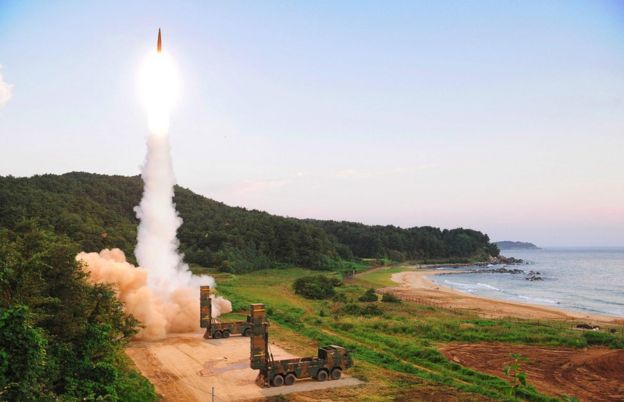North Korea preparing more missile launches, says South
North Korea preparing more missile launches, says South
South Korea says it has seen indications that the North is preparing more missile launches, possibly an intercontinental ballistic missile.
It said it was strengthening its controversial US-made Thaad missile defence system after the North's test of a nuclear bomb at the weekend.
The South has carried out live-fire exercises in response to the test.
The US has warned that any threat to itself or its allies will be met with a "massive military response".
The North says it tested a hydrogen bomb that can fit on to a long-range missile.
Pyongyang has repeatedly defied UN sanctions and international pressure by developing nuclear weapons and testing missiles, and the provocations have only intensified.
In the past two months it has conducted intercontinental ballistic missile tests, sending one over mainland Japan into the Pacific Ocean. It has also threatened to fire missiles towards the US Pacific territory of Guam.
The United Nations Security Council is to hold an emergency meeting later on Monday to discuss its response.
- How should Trump handle North Korea?
- What are the military options?
- What's at North Korea's nuclear site?
- Can we work out the power of the tested bomb?
Ahead of that meeting, South Korea and Japan's leaders had agreed to push for a stronger UN resolution on North Korea, said a South Korean presidential palace spokesman.
The Security Council last imposed sanctions in August, targeting North Korean exports.
What has the South said?
Chang Kyung-soo, a defence ministry official, told parliament: "We have continued to see signs of possibly more ballistic missile launches. We also forecast North Korea could fire an intercontinental ballistic missile (ICBM)."
No timeframe was given for any launches but this Saturday, the anniversary of the foundation of the North's regime, or 10 October, the establishment of the ruling Workers' Party of Korea, were possible dates.
The ministry also told parliament the US would seek to deploy a nuclear-powered aircraft carrier to seas off the peninsula.
It said it would temporarily deploy four more launchers of the US Thaad (Terminal High-Altitude Area Defence) missile defence system to join the two already at the site in Seongju, south of Seoul.
Both China and Russia are strongly opposed to the Thaad deployment.
 AFP/GETTY IMAGES
AFP/GETTY IMAGES
The South's Defence Minister Song Young-moo said it was now presumed the North had reduced its nuclear warhead in size to below 500kg (1,100lbs), and would be able to fit one on an ICBM.
The ministry said there would be more live-fire drills in the South this month, involving Taurus air-to-surface missiles mounted on F-15 jets.
Monday's drills simulated the targeting of the Punggye-ri nuclear site in Kilju County, where North Korea carried out its bomb test.
South Korea and the US had also agreed "in principle" to revise current guidelines so that the South could double the maximum payload of its ballistic missiles, Yonhap also reported.
How did the nuclear test unfold?
On Sunday, seismologists started picking up readings of an earth tremor in the area where North Korea had conducted nuclear tests before.
 REUTERS/KCNA
REUTERS/KCNA
The US Geological Survey put the tremor at 6.3 magnitude.
North Korea later confirmed its sixth and most powerful nuclear test, detonating what it said was a hydrogen bomb that could be loaded on to a long-range missile.
Pyongyang then released pictures of leader Kim Jong-un with what state media said was a new type of hydrogen bomb.
- Kim inspects 'nuclear warhead': A picture decoded
- 'Tunnel collapse' at nuclear site may provide clues
Officials in China said they were carrying out emergency radiation testing along the border with North Korea.


Post a Comment